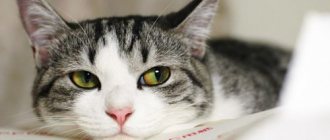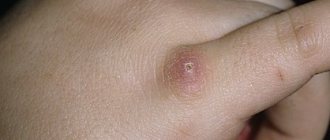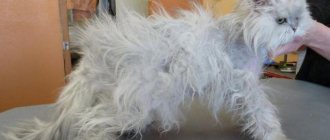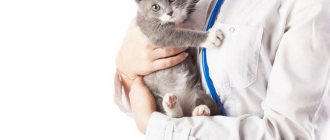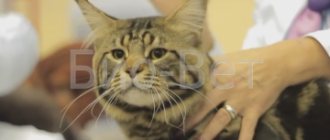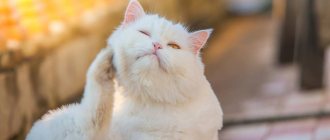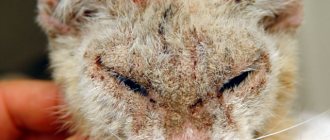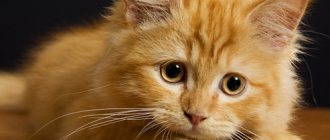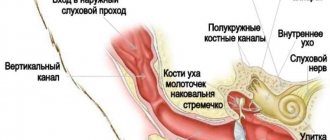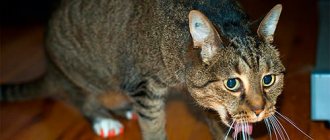Hair change in cats is a normal seasonal phenomenon, although it causes a lot of worries for owners. A shedding pet leaves fur on the furniture, which must be removed with a vacuum cleaner and brush. A healthy cat does not shed profusely; otherwise, disturbances in the functioning of the body should be suspected. The animal must be shown to a veterinarian, because severe cat shedding can be a symptom of exhaustion and systemic pathologies.
Why cats and kittens shed
Shedding is a natural process of fur renewal. Old hairs fall out of the follicles, and new ones grow in their place. Depending on the breed and living conditions of the animal, the change of coat can be continuous or seasonal. Cats of all breeds shed except hairless cats.
Seasonal molt
Cats that shed seasonally change their coat twice a year. When spring and autumn come, fur renewal is due to climate changes: by winter the animal becomes warmer, becomes fluffier, and by summer it becomes lighter. Seasonal molting lasts up to 9 weeks. In long-haired individuals it is more pronounced in spring. In short-haired cats the intensity is the same.
Sometimes a cat sheds slightly in winter, reacting to changes in weather: the arrival of frost or thaw. Same in summer.
In addition to seasonal molt, short-term juvenile molt is observed. In small kittens, the change of coat to adult begins at six months, the hairs become stiffer, the color becomes more intense, and patterns appear on the body.
Change of coat
Year-round molting
Some breeds shed throughout the year. Owners have to constantly care for their pets' fur.
Another reason why a cat sheds all year round is the lack of walking. The adapted cat's body begins to react to the temperature in the home. It’s warm in the summer, and when winter comes, the heating radiators are turned on - the thermometer readings change slightly, so at home, fur is always growing.
Cats love to walk in nature
Combing
They comb out the fur only when shedding; normally this should not be done.
To do this, use combs with elongated, hard bristles with sharp ends. Soft teeth or rounded ends do not allow for effective hair pulling. Of course, you need to comb out the brush carefully, with straight (not circular) movements and not press it tightly. Combing begins from the back, moving from the neck to the tail. Make parallel movements with the comb.
They gradually descend to the stomach, and after combing the entire body, they move to the legs. They are processed from top to bottom, first from the outside and then from the inside. Finally, the hair on the head is combed out.
Increased shedding and its causes
When the fur comes out for a long time and strongly, pathological shedding is diagnosed. The table lists the reasons why cats shed heavily.
| cause | description of the problem |
| genetic predisposition and congenital pathologies | hypotrichosis – genetically determined excessive hair loss, in which the cat has no fur left by the age of 3 months; hereditary seborrhea - a malfunction of the sebaceous glands, accompanied by baldness and an unpleasant odor of the skin |
| unbalanced diet | when there is a deficiency of nutrients and vitamins in food, the cat begins to lose weight, the fur first becomes dull, forms clumps, and then falls out very much; but excess nutrition is no less dangerous than hypovitaminosis; excessive feeding of a pet with vitamin preparations leads to intoxication, accompanied by diarrhea, vomiting, frequent urination, and baldness |
| period of pregnancy and lactation | cats preparing for motherhood must be fed with special food for pregnant women, saturated with nutrients in optimal concentrations, otherwise the expectant mother may lose weight, the body in which embryos develop and milk is synthesized will not have enough strength to maintain its own vital functions |
| severe stress | a frightened, nervous cat that has undergone a change in environment or diet may have hair coming out in patches or on a significant part of the body |
| hormonal disbalance | shedding is profuse in cats with endocrine pathologies or taking medications to suppress sexual desire |
| frequent washing | ; domestic pet that does not stain its fur does not need frequent bathing , otherwise the coat loses its protective lubricant, becomes brittle, and falls out |
| allergic reaction | The reasons why a cat goes bald can be different types of allergies: food, atopic (due to inhalation of pollen, smoke, perfumes, other irritants), contact (when interacting with chemicals, an uncomfortable collar, other skin irritants); in addition to molting, rashes, ulcers, itching indicate an allergic process |
| external parasites and fungal infection | fleas and ticks in the process of life cause unbearable itching and irritation of the skin, resulting in intense molting; Patchy baldness is inevitable due to ringworm |
| response to therapy | Some medications cause a side effect - hair loss; a visit to the veterinarian is required to replace the unsuitable drug |
| constant contact with battery | In winter, cats like to bask on the heating radiator, do not leave the device for several hours, under the influence of temperature the hairs dry out and begin to come out; to prevent the fur from getting in, arrange another warm resting place for the animal |
| oncological diseases | malignant cells attack all organs and systems, including hair follicles |
Treatment
Having made a diagnosis, the veterinarian prescribes treatment. It will be aimed at restoring the coat, as well as eliminating the cause of hair loss in the cat.
Treatment methods:
- If the problem of hair loss is associated with an allergic reaction of the cat to certain allergens, the animal must be completely protected from this allergen. After this, medications are prescribed to enhance immunity. If the allergy is caused by food, then it is necessary to put the cat on a hypoallergenic diet.
- For skin lesions caused by ectoparasites (ticks, fleas and lice), a veterinarian will prescribe special antiparasitic drugs (fleas in a cat). You will need to include vitamins and nutritional supplements in your diet to strengthen your cat’s immunity.
- If hair loss on the cat’s body appears as a result of an infectious disease, monovalent and associated vaccines against microsporia and trichophytosis are used - Mikkanis, Vakderm, Vakderm-F, Microderm, Polivak-, Pushnovak, etc.
When treating ringworm, veterinary specialists also use medications such as: Ketoconazole, Itraconazole, Griseofulfin, and so on. In this case, it is recommended to use immunosupportive agents and medications to improve metabolism. It is important to remember that ringworm is transmitted to humans.
- Hair loss caused by stress in cats is treated with special calming medications.
- Treatment of hair loss caused by subcutaneous parasites is described in our articles - demodicosis in cats, otodectosis in cats, notoedrosis.
- For endocrine disorders in a cat's body, hormonal medications are prescribed.
How to reduce cat shedding
In order to properly treat excessive shedding, it is necessary to find out what caused it. Therefore, the first thing the owner should do is contact a veterinary clinic. Do not treat your cat at your own discretion: incorrect actions will aggravate the condition. The veterinarian will find out why the cat sheds, prescribe appropriate treatment, tell you what drug to use for infection, seborrhea, parasites, and whether the cat’s diet needs to be changed.
In the vast majority of cases, a cat sheds due to poor-quality food, so the veterinarian gives advice on diet and recommends vitamins to strengthen the coat.
Anti-shedding food
With an unbalanced diet, after losing weight, a deterioration in the condition of the coat follows. The owner has two options on what to do to prevent the cat from shedding any more:
- buy high-quality premium or holistic food that contains a full range of vitamins and nutrients;
- diversify your natural diet, include dietary supplements and vitamin preparations.
The best brands of complete food are Acana, Royal Canin, Applaws, Brit.
Do not feed your cat only canned food, use it as a treat. This type of food does not contain the required amount of substances beneficial to the coat.
To make seasonal shedding easier, add chicken yolk and fish oil to your cat's diet. These products are valuable sources of minerals, vitamins, and fatty acids that have a general strengthening effect on the cat’s body, ensuring smooth and healthy fur.
Vitamins for cats
Buy vitamin preparations on the recommendation of a veterinarian, do not exceed the dosage so that your pet does not suffer from hypervitaminosis.
Which vitamins to buy depends on the purpose of use:
- for strength and health of the coat - group B, kelp, iodine;
- to prevent the cat from shedding excessively - Biofaktory Felvit Multi, Beaphar Laveta Super, Beaphar Kitty's + Taurine-Biotine, GimCat Katzentabs;
- to reduce the time during which a cat sheds, brewer's yeast.
Short-haired and long-haired
For a person who suffers from allergies or does not have the opportunity to often care for cat hair, an important condition for choosing a pet is seasonal shedding. Do not choose a cat with long hair and lush undercoat. The hairs of the cat's undercoat come out more abundantly than the guard hairs and settle on furniture and clothes. The optimal breed for an allergy sufferer is one with short hair and little undercoat or hairless.
Cats that shed frequently
Let's list which cat breeds have the most severe process of hair loss:
- British and Scottish cats shed all year round;
- Maine Coons, Siberian cats, and other long-haired breeds - they are characterized not only by seasonal shedding, but also by less intense hair loss throughout the year;
- Angoras, Somalis, Burmese, American Curls are also long-haired, but little hair falls out, long hairs are easily removed from furniture.
Cats that don't shed
Breeds of non-shedding cats that you don’t have to fuss with:
- Siamese, Oriental, Abyssinian, Bengal, Singaporean - these cats have no or short undercoat, so shedding takes place in a short time, and much less hair falls out;
- Sphynx cats;
- curly cats - laperm, rex.
Resort by the Battery
Cats were “conceived” as free creatures, but people domesticated these beauties and thereby violated some of the laws of their nature. It is much easier for rural cats - they always have the opportunity to walk freely in the yard. Some go on a spree for a week or more. And the molting of such revelers, as a rule, proceeds normally. But if the pet practically does not get out of the four walls, there can be no talk of norms.
Cats sense the approach of winter with their skin . Nature dictates that they grow fur and prepare for frost. Apartment pets have a completely different “dictation”. Home light bulbs and hot radiators mean eternal summer for a cat. At such a resort, growing a fur coat is impractical and even harmful. On the contrary, the fur falls out in clumps to allow the body to breathe freely. Heavy shedding in an apartment pet is a kind of prevention of overheating.
But all cats love warmth. Even if the apartment is plus thirty, the cat will gladly cling to the radiator and fall asleep with her in his arms. He would be glad to quickly lose all his fur, but not this divine warmth. But a wise owner should not indulge his pet - of course, if he does not intend to clean carpets and furniture from wool all year round.
You should not let your cat near the radiator often. The apartment must be regularly ventilated, if possible, install air fresheners and air conditioners. And the cat needs to be allowed out at least onto the balcony, especially in winter. Believe me, nothing bad will happen if the cat spends 15-20 minutes in cool, fresh air.
Memo for the owner
If your cat sheds abnormally heavily, or if you need to promptly prevent excessive hair loss, follow these recommendations:
- Don't buy economy cat food. They practically lack the nutrients and vitamins the animal needs.
- Brush your cat regularly. Use a furminator or a comb with flexible teeth.
- Bathe your pet periodically using grooming products. To strengthen hair follicles and speed up coat change, buy cat shampoos containing vegetable oils, tocopherol, retinol, panthenol. Find out from your veterinarian which product is suitable and how often to wash your cat so as not to harm the coat.
- Don't stress your pet. Treat him kindly, pet him, play with him. If the animal becomes nervous, give a sedative, for example, Feliway, as directed.
- Make sure the air in your home remains moist.
- If possible, let your cat go for a walk in the yard.
If your pet has lost weight and begun to shed intensively, there is a high probability of infection with helminths that take away nutrition from the body. To prevent helminthiasis, carry out antiparasitic treatments according to the schedule established by the veterinarian.
Use a sticky roller to remove cat hair from furniture and clothing, or use a vacuum cleaner with a brush attachment to clean the carpet.
Grooming salons offer express shedding procedures. This is a good way to speed up the cat's natural shedding period. The specialist applies a special composition to the animal’s fur, then washes it, dries it while combing it out.
Hormonal disorders, infectious and oncological diseases that cause molting are treated by a veterinarian. The course and dosage of medications is also determined by a specialist.
